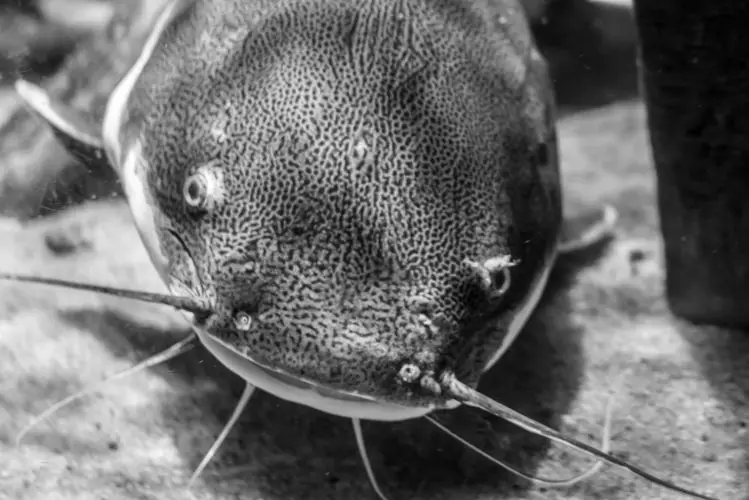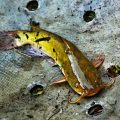Catfish use their barbels mainly to detect food from their surroundings and taste. The barbel has olfactory ability in it to help it smell what is in the water to help it find food. The barbel allows the catfish to taste the food slightly before they eat it. They have many ways of perceiving with their senses. Catfish are one of the most diverse and most perceptive species of fish ever and are also considered one of the most sensorially perceptive species on this planet.

What are catfish barbels?
If you have ever seen a catfish, you must have noticed many long, thin, hair-like stuff growing around their mouth. Your first thought might be cat whiskers. That’s exactly what they are, and partially the reason why this species is named “catfish”, but they have a different name, “barbels”.
The word “barbel” comes from the Late Latin word Barba, which means beard. You can imagine barbels as catfish beards. These are actually not hair, rather fleshy filaments or appendages growing out of their mouth. Every catfish has up to eight of these barbels on its chin or the side of its mouth. There is also a separate fish named Barbel, and you must not mistake the two. Barbel fish is a freshwater fish under the genus Barbus.
What is the purpose of catfish barbels?
Have you wondered why cats have whiskers? Those tactile hairs around their mouth act as their third vision, helping the felines to navigate their environment. It is an additional sensory input, just like antennae for insects. In the same way, the barbels on catfish also have a purpose.
Every one of these barbels is equipped with olfactory senses. In other words, the sense of smell. They are also coated with small cells that act like taste buds. These taste buds and olfactory senses work together to help the catfish in tasting and smell. This is so that they can look for food.
How do catfish use their barbels more in depth?
Catfish first use their barbels and other senses of smells to determine whether there is a potential source of food nearby. They can actually sense a food source from quite a far distance. If they detect one, they can also get an idea of how far it is by the intensity of the smell. When the catfish reaches the source of food, they taste it a little with their barbels before putting it in their mouth.
However, the taste buds in their barbels are not very strong, so catfish will have to put the food in their mouth to determine whether it is edible. If it is edible, then they will quickly eat it. But if it isn’t, they will spit it out and continue with their search.
Do catfish only use their barbels for taste and smell?
The answer is a big fat no. In fact, you can’t even imagine the sheer number of sensory organs a regular catfish owns. The barbels are not even half of it. There are other ways, too, through which catfish can gain the sense of taste and smell while looking for food.
For one, their entire body is filled with taste buds, every inch of it. These are called chemoreceptors, which act as taste receptors. Their mouth and gill rakers are also filled with taste buds, not to mention their fins, back, belly, sides and even the tail.
That’s why it is said that if you were a catfish, you could taste a slice of pizza just by sitting on it. Since it is spread all over their body, they can taste the water all over while moving through it! Here is a fun fact, a catfish just six inches long has more than a quarter-million taste buds on its body. So for one of those huge ones, the number is basically uncountable.
As for the smell, other than their barbels, catfish also have nostrils. They are called “nares”, which are two small openings located on either side of their snout. These openings lead to small chambers with a bunch of folds. The folds contribute to increasing the surface area used for smelling the catfish. The more folds you have, the better. There are hairlike projections on these folds that act as olfactory receptors. Channel catfish have as many as 140 folds.
Why do catfish need barbels?
You might be thinking about why catfish need to rely on their sense of smell to look for food. Most other fish would just use their eyes to detect potential prey, but the truth is, catfish eyes remain more or less useless. This is because their usual habitat is dark.
Most catfish live in the deep, murky waters of the rivers, ponds, and other water bodies. Those parts of the water are so dark that it’s nearly impossible for them to see properly, and because of this reason, some catfish have even evolved to become blind. It is difficult for them to search for food by simply relying on their eyesight in such a situation.
Moreover, catfish reside in geographically diverse areas. You can find them in the tidal rivers of the Atlantic. You can find them in murky reservoirs of the Plain States. You can find them under a frozen sheet of ice in a pond during winter, and you can also find them in high-temperature waters during summer.
For this reason, catfish need to have extremely high adaptability. Nature has equipped them with a highly sensitive nervous system to navigate their surroundings that they can pick up on every little environmental cue and adjust themselves accordingly. That’s exactly why they have so many sensory organs, including barbels. In conclusion, barbels are an extraordinary organ for these extraordinary species of fish, and now you know why and how they use it.












Pingback: How do Catfish Find Food? | Reel Fishing Guru
Pingback: What do Catfish Eat? | Reel Fishing Guru
Pingback: What is a Flathead Catfish? | Reel Fishing Guru
Pingback: What Species of Catfish Are There in Texas? | Reel Fishing Guru
Pingback: What Is a Wallago Attu? | Reel Fishing Guru
Pingback: Differences between Catfish and Carp | Reel Fishing Guru
Pingback: Do Catfish Sting? | Reel Fishing Guru
Pingback: Differences Between Catfish and Trout | Reel Fishing Guru
Pingback: What Is the Difference Between Catfish and Mahi Mahi? | Reel Fishing Guru
Pingback: What is the Difference Between Grouper and Sturgeon? | Reel Fishing Guru
Pingback: Do Catfish Like Frozen Bait? | Reel Fishing Guru
Pingback: What is a Wels Catfish? | Reel Fishing Guru